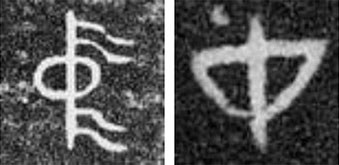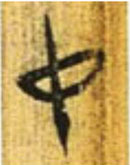I Ching, Yijing or Zhou Yi
"Oracle of the moon": © 2000 LiSe
 Yi Jing, Oracle of the Moon
Yi Jing, Oracle of the Moon

中
Hex.61 CENTER
hitting the target

Two zhong characters on oracle bones
Zhong1 means center, to be in the center, middle, among, medium, halfway. Pronounced as zhòng: to hit the target, to be struck. It is a picture of a pole with a banner in the middle of a circle.
A famous story from the Mahabharata (a Sanskrit epic of ancient India about the sons of Kunti):
When the master of archery was teaching the sons of Kunti, he told them to shoot a bird on a high rampart. He asked them one by one what they saw when aiming the arrow.
One saw a rampart with a bird, another only the bird. But Arjuna saw only an eye. He never missed his target because he was one with it, he was in the center.
In the Yijing, in hex.40, top line: The Gōng (duke) shoots a falcon on the top of a high rampart. He hits it. Harvest is sure.

A zhong-character on silk
In the Yi zhong is part of the name of hexagram 61, but in the other hexagrams there are only six places where it occurs. Two of them refer to the sun in the center of heaven: noon.
Center of the forest in hex.3 line 3 is its most simple use.
Center of the forest in hex.3 line 3 is its most simple use.
Three occurences are about 'moving central': 24 line 4 and 42 lines 3 and 4. Moving central can be 'going halfway', 'avoiding any excess', but also 'moving in the center'.
中國
Zhongguo, China
Moving in the center is being one with what one does, or following the 'road of the mean', a combination of 'being one with what one does' with 'avoiding any excess'.
China is 'The Middle Kingdom', Zhongguo: the country situated in the center of the earth. Where you are is always the center of the earth: it stretches in all directions around you.
Very interesting is the meaning of 'hitting target' (see Kunst 1985), which expands 'moving central'. You are not only staying in between two extremes, but 'hitting target' while doing it.